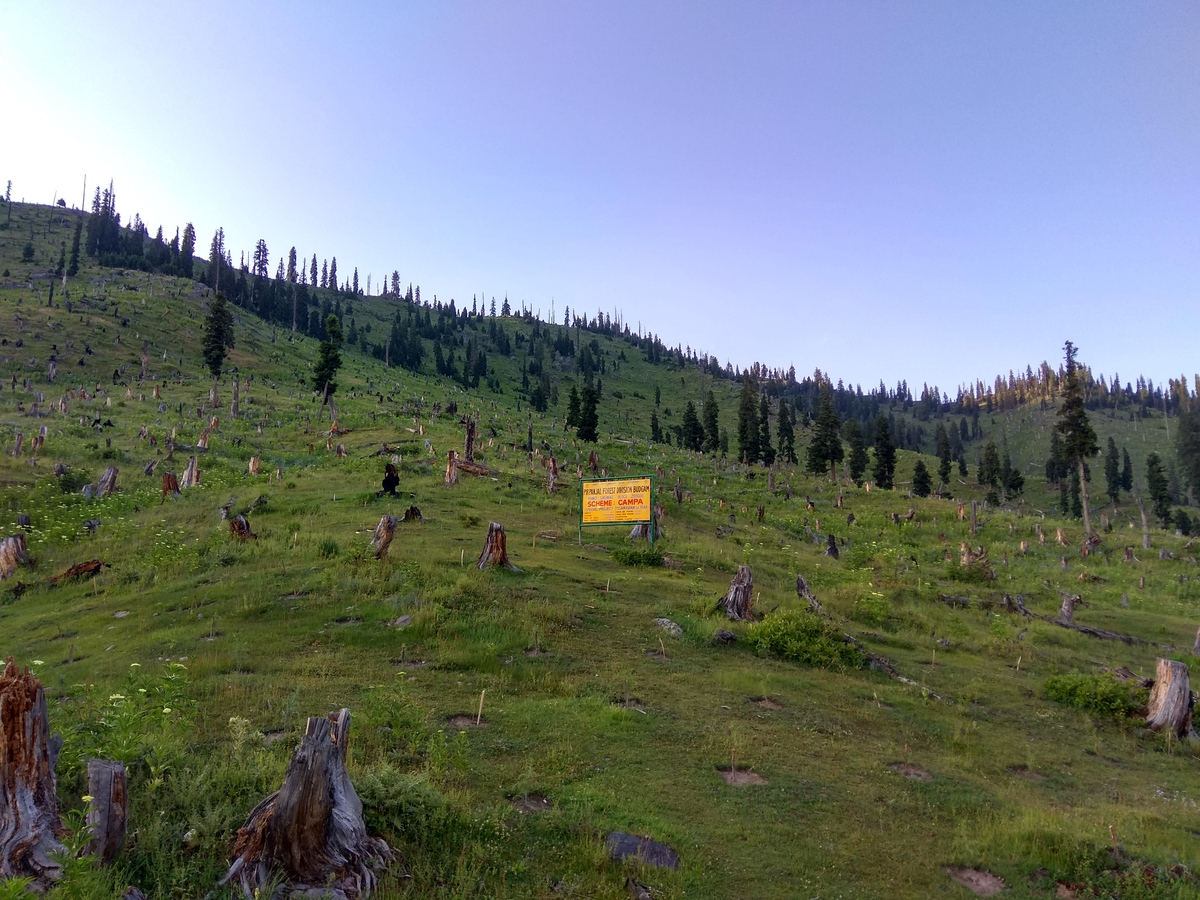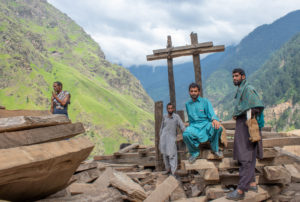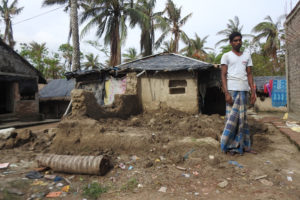In one month, Mohammad Adil, a research scholar studying the reproductive biology of medicinal plants, made two journeys to Afarwat, a mountain in the north of Jammu and Kashmir. He intended to collect samples of Arnebia benthamii, commonly known as Kahzaban.
Both times he returned empty-handed.
The flowers of Kahzaban have been found to help people with heart problems. The plant also contains high levels of antioxidants.
“Eight years ago Kahzaban was abundant, but it is rarely found now,” said Adil.
Eventually, in August this year, he collected his sample in the upper reaches of Sonamarg, a remote hill station.
The union territory of Jammu and Kashmir is famous for its rich variety of plants with medicinal qualities, which are used in medical treatments, aromatherapy and cosmetics. But demand for these plants from Europe, China, Japan and other countries has made the region a fertile ground for smugglers.
See: Timber smugglers loot Kashmir’s forests during pandemic lockdown
See: Poaching spikes amid lockdown in South Asia
Researchers have documented 1,123 medicinal plants growing in Jammu and Kashmir. Irshad Ahmad Nawchoo, head of the school of biological sciences at the University of Kashmir and a member of the J&K Medicinal Plants Board, told The Third Pole that the majority are threatened.
![Road construction without any understanding of the ecosystems has led to immense loss of medicinal plants in Kashmir [image by: Mudassir Kuloo]](https://dialogue.earth/content/uploads/2020/10/habitat_destruction_road_constructed_in_kashmiri_which_had_once_immense_medicinal_plants_Pic_by_Mudassir_Kuloo.jpg)
A study published in 2018 identified 50 native medicinal plant species in the region as in need of “immediate conservation action”, based on ecological and socioeconomic factors.
Plant power
The Himalayas are one of the world’s 36 biodiversity hotspots, and are rich in endemic plants (found nowhere else on Earth).
OP Sharma, former director of the State Forest Research Institute for Jammu and Kashmir, said some of region’s medicinal plants are rarely found anywhere else.
Their uses are extensive. Saussurea costus, a type of thistle known locally as kuth, is used to treat joint and back pain, ulcers, dysentery and fever. From Aconitum heterophyllum (paewakh), a lotion is made to treat headache and cough. A decoction made from the leaves of Dioscorea deltoidea (kraeth) is used as eyedrops to treat infections and sharpen eyesight. But their usefulness has led to exploitation; the plants described are all endangered.
Unrestrained illegal trade
A resident of Sonamarg told The Third Pole that in the first week of September he walked hours to the upper reaches.
There, he spotted a threatened Trillium govanianum plant, commonly known as Tripater, and uprooted it.
“We extract plants from the soil then sell to people. This is how we make our living. We get INR 2,500 (USD 34) for each kilogramme of Trillium,” he said.
Trillium govanianum is thought to cure many sexual disorders, especially infertility in men. It is also a cancer treatment, Akhtar H Malik, a botanist at the University of Kashmir, told The Third Pole.
A resident of the town of Tangmarg said locals are paid INR 2,500-3,000 (USD 34-41) per kg of Trillium govanianum. After that it is sent to Chandigarh in Punjab in trucks, then to European countries and China.
See: Illegally collected Himalayan plant seeds sold in UK
“It has a value of INR 70,000 [USD 950] per kg there,” he said.
The extraction of many medicinal plants is banned in Jammu and Kashmir. However, smugglers get around this by sending local men and women to the forests to pick the plants, as well as wood and dried leaves. This makes it difficult for forest guards to identify wrongdoing.
Mohit Gera, principal chief conservator of forests for Jammu and Kashmir, said many measures have been taken to preserve the forests and that “nobody can extract forest produce without permission”.
Nawchoo, disagreeing, said, “There are no exact figures on how much is being sold in Kashmir as the majority of medicinal plants are being smuggled and not recorded.” He added that forest dwellers are not aware that the plants are being overexploited.
Malik said some plants (Trillium govanianum, Fritillaria roylei, Saussurea costus, Arnebia benthamii) cost INR 50,000-100,000 (USD 680-1,360) per kg in the international market.
Multiple stressors
According to Sharma there are many reasons for the decline of medicinal plants. “Smuggling is a main factor. But construction of roads, pollution and stress on habitat also contribute,” he said.

He said some medicinal plants no longer grow at lower altitudes.
See: Climate change threatens Tibet’s rare alpine plants
Deforestation is another problem. Forests cover over 20,230 square kilometres of Jammu and Kashmir – about 10% of its total area.
However, over 100,000 kanals (50 sq km) of forest has been encroached on over the past 30 years, according to the J&K Forest Department.
Nawchoo of the University of Kashmir said the development of tourist resorts has caused huge deforestation and destruction of habitats. “Hotels have been developed. Our researchers rarely found the majority of medicinal plants [in these areas],” he said.
![Khilanmarg meadow at Gulmarg where tourists visit and medicinal plants have vanished [image by: Mudassir Kuloo]](https://dialogue.earth/content/uploads/2020/10/Khilanmarg_meadow_at_Gulmarg_where_tourists_visit_and_medicinal_plants_have_vanished_Pic_by_Mudassir_Kuloo-scaled.jpg)
He said the loss of plants could lead to habitat destruction and affect the entire ecosystem, as insects are affected.
Unchecked decline
“Government, NGOs and the general community are not keen to preserve forests. Some medicinal plants have value not only at a national level, but internationally,” said Nawchoo, calling for the government to stop the unchecked extraction.
Under India’s Biological Diversity Act, 2002, states set up biodiversity boards. However, for years Jammu and Kashmir did not have such a board; the Act was not applicable because of its special status under Article 370.On September 3, 2020, the board set up in 2015 was replaced by the Biodiversity Council.
Nurseries offer hope
Wahid Hassan is the former nodal officer at the Medicinal Plants Board – which means he coordinated between the board’s officials, members and other authorities. He said the lack of a formal market for the plants causes problems.
“The marketing part is missing. There is no mechanism for markets. Traders are exploiting farmers,” he said.
“We could generate huge employment. Initially it could be an INR 500 crore [USD 68 million] industry then can go to INR 2,000 crore [272 million] as it has tremendous potential.”
Gera, the principal chief conservator of forests, said that the Biodiversity Council wants people to cultivate medicinal plants, creating employment opportunities. This scheme, which is at an initial stage, has been implemented in some locations at a small scale.
A nursery has been established in Srinagar by the Medicinal Plants Board in collaboration with Department of Floriculture Kashmir, where 10 high-value medicinal plants are being propagated for distribution to farmers and government organisations.
There is also a proposal for six farmers to take on the mass cultivation of medicinal plants, set up three more nurseries and two marketing divisions. Workers will be trained to take cuttings from wild plants for the nurseries, rather than uprooting them.
Malik stressed the importance of involving local people and said part of the government’s scheme is to raise awareness among forest dwellers.
Nawchoo called for the government to provide financial support to growers and act as a purchaser.
Without urgent action, he said, within 10 years the majority of the region’s medicinal plants will vanish.
![<p>Trillium, an important medicinal plant, is becoming increasingly hard to find in Kashmir [image courtesy: Akhtar H Malik, Kashmir University]</p>](https://dialogue.earth/content/uploads/2020/10/Trillium_medicinal_plant_Arranged_from_Akhtar_H_Malik_a_botanist_of_Kashmir_University-300x225.jpg)







